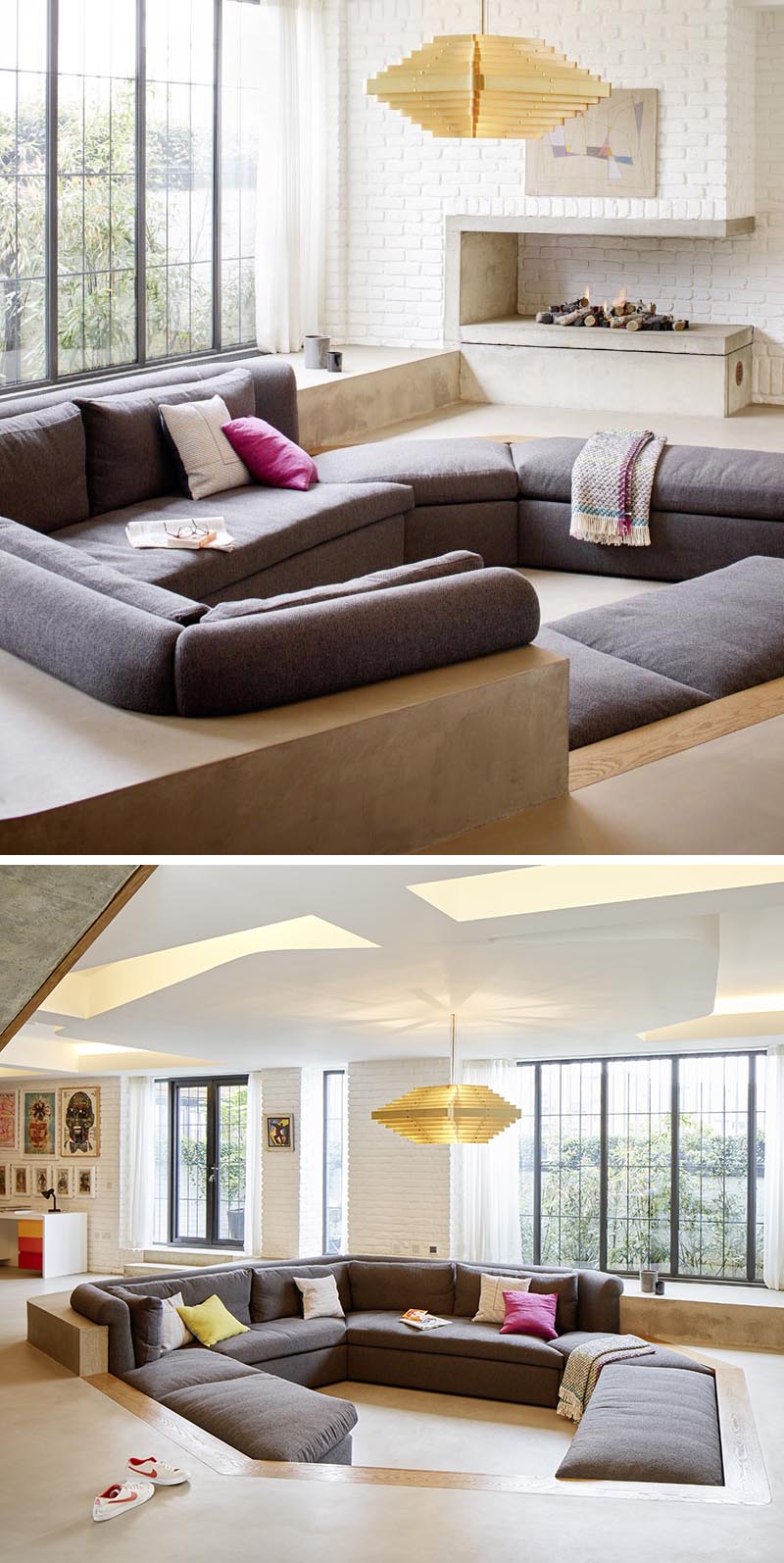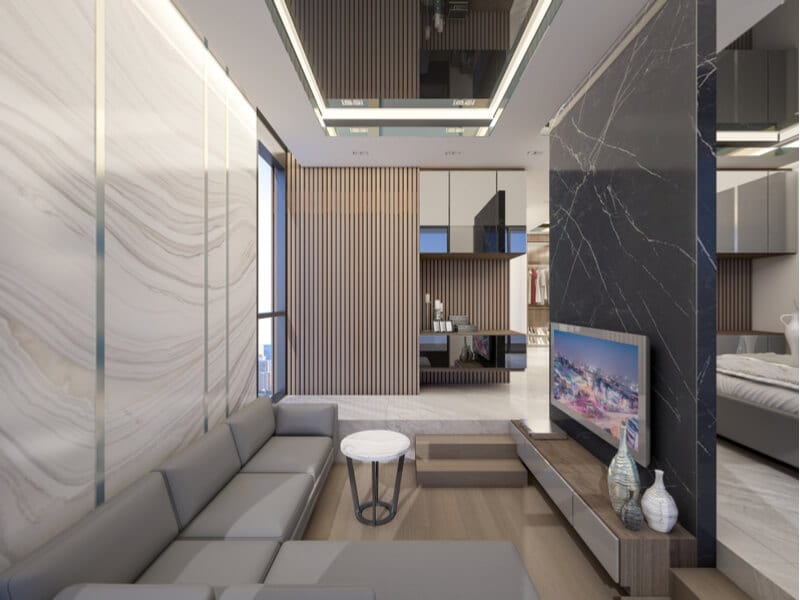A sunken living room is a design feature in a home where the living room is located on a lower level than the rest of the house. This type of living room is typically accessed by a small set of steps or a slight slope. It is a popular design choice for modern or contemporary homes, but it can also be found in older homes as well. The name "sunken" refers to the fact that the living room is physically lower than the other rooms, creating a sunken or lowered appearance. Definition of Sunken Living Room
A sunken living room is a unique design element that adds depth and dimension to a home. It is often used to create a visual separation between the living room and other areas of the house, such as the dining room or kitchen. This type of living room can also provide a cozy and intimate atmosphere, making it a popular choice for entertaining or relaxing with family. What is a Sunken Living Room?
There are many ways to design a sunken living room, depending on the style and layout of your home. One popular design idea is to have a sunken living room adjacent to a raised dining room, creating a multi-level effect. Another option is to have the sunken living room in the center of a larger room, with the rest of the house on a higher level. This can create a dramatic and open feel to the space. Additionally, you can incorporate different materials, such as stone or wood, to add texture and interest to the sunken living room. Sunken Living Room Design Ideas
Like any design element, there are both advantages and disadvantages to having a sunken living room in your home. Some pros include the unique visual appeal, the creation of separate zones in an open-concept layout, and the potential for increased natural light. However, some cons to consider are the potential for safety hazards, such as tripping or falling down the steps, and the added cost of construction and maintenance. Pros and Cons of a Sunken Living Room
A raised living room is the opposite of a sunken living room, where the living room is located on a higher level than the rest of the house. While both can add interest and dimension to a home, a raised living room can also create a sense of grandeur and luxury. It can also provide better views and natural light. However, a sunken living room may be more suitable for smaller spaces, as it can create a cozy and intimate atmosphere. Ultimately, the decision between a sunken or raised living room will depend on the specific needs and preferences of the homeowner. Sunken Living Room vs. Raised Living Room
If you are interested in incorporating a sunken living room into your home, there are a few steps to follow. First, consult with a professional to determine if this design is feasible for your space and budget. Next, decide on the location and layout of the sunken living room, considering factors such as natural light and accessibility. Then, hire a contractor to dig out the lower level and create the steps or slope leading to the living room. Finally, you can add the finishing touches, such as flooring and furniture, to complete the look. How to Create a Sunken Living Room
As mentioned earlier, safety should be a top priority when considering a sunken living room. Here are a few tips to ensure the safety of you and your guests: Sunken Living Room Safety Tips
The cost of creating a sunken living room will vary depending on factors such as the size of the space, the materials used, and the extent of the construction required. On average, homeowners can expect to spend anywhere from $5,000 to $30,000 for a sunken living room remodel. It is important to budget and plan accordingly to avoid any unexpected expenses. Sunken Living Room Remodeling Costs
Once your sunken living room is complete, it's time to decorate and make it a cozy and inviting space. Here are a few ideas to get you started: Sunken Living Room Decorating Ideas
The concept of a sunken living room can be traced back to ancient times, where it was used in Greek and Roman architecture to create grand entrances and impressive spaces. In modern times, the trend became popular in the 1950s and 1960s, as a way to create a more open and fluid layout in homes. Today, sunken living rooms continue to be a popular design choice, offering a unique and stylish feature in homes around the world. Sunken Living Room History and Origins
The Benefits of a Sunken Living Room in Home Design

What is a Sunken Living Room?
 A sunken living room, also known as a conversation pit, is a unique design feature that involves lowering the floor of a room to create a seating area below the level of the rest of the room. This design trend gained popularity in the 1960s and 1970s and has continued to be a popular choice for homeowners looking to add a touch of luxury and sophistication to their homes.
A sunken living room, also known as a conversation pit, is a unique design feature that involves lowering the floor of a room to create a seating area below the level of the rest of the room. This design trend gained popularity in the 1960s and 1970s and has continued to be a popular choice for homeowners looking to add a touch of luxury and sophistication to their homes.
The History of Sunken Living Rooms
 The concept of sunken living rooms dates back to ancient civilizations such as the Greeks and Romans, who built their homes with sunken areas for communal gatherings and entertainment. In modern times, the idea was popularized by architect Bruce Goff in the 1920s and gained widespread attention in the 1960s when it was featured in the hit TV show, "The Jetsons."
The concept of sunken living rooms dates back to ancient civilizations such as the Greeks and Romans, who built their homes with sunken areas for communal gatherings and entertainment. In modern times, the idea was popularized by architect Bruce Goff in the 1920s and gained widespread attention in the 1960s when it was featured in the hit TV show, "The Jetsons."
The Meaning of a Sunken Living Room
 A sunken living room adds depth and dimension to a home's interior design. It creates a unique and intimate space for relaxation and conversation, separate from the rest of the house. This design feature also adds a sense of grandeur and elegance to a home, making it a popular choice for luxury homes and upscale hotels.
A sunken living room adds depth and dimension to a home's interior design. It creates a unique and intimate space for relaxation and conversation, separate from the rest of the house. This design feature also adds a sense of grandeur and elegance to a home, making it a popular choice for luxury homes and upscale hotels.
The Benefits of a Sunken Living Room
 Apart from its aesthetic appeal, a sunken living room also offers practical benefits. By being positioned lower than the rest of the house, it allows for better airflow and natural light to enter the space. This can help to keep the room cool and provide a brighter and more inviting atmosphere. Additionally, the lowered floor creates a cozy and secluded space, perfect for intimate gatherings or quiet moments of relaxation.
Apart from its aesthetic appeal, a sunken living room also offers practical benefits. By being positioned lower than the rest of the house, it allows for better airflow and natural light to enter the space. This can help to keep the room cool and provide a brighter and more inviting atmosphere. Additionally, the lowered floor creates a cozy and secluded space, perfect for intimate gatherings or quiet moments of relaxation.
Incorporating a Sunken Living Room into Your Home Design
 If you're considering adding a sunken living room to your home, there are a few things to keep in mind. First, it's essential to consult with a professional architect or designer to ensure that the structure and foundation of your home can accommodate the lowered floor. You'll also want to consider the placement of the sunken living room in relation to the rest of the house and how it will flow with the overall design.
In conclusion
, a sunken living room is a unique and sophisticated addition to any home. Its history, meaning, and practical benefits make it a popular choice for homeowners looking to elevate their interior design. So, if you're looking to add a touch of luxury and charm to your home, consider incorporating a sunken living room into your design plans.
If you're considering adding a sunken living room to your home, there are a few things to keep in mind. First, it's essential to consult with a professional architect or designer to ensure that the structure and foundation of your home can accommodate the lowered floor. You'll also want to consider the placement of the sunken living room in relation to the rest of the house and how it will flow with the overall design.
In conclusion
, a sunken living room is a unique and sophisticated addition to any home. Its history, meaning, and practical benefits make it a popular choice for homeowners looking to elevate their interior design. So, if you're looking to add a touch of luxury and charm to your home, consider incorporating a sunken living room into your design plans.



































































